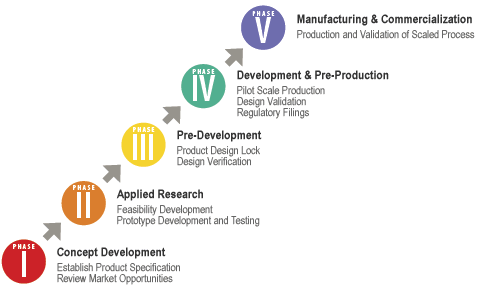In the world of marketing, there are several steps in which a company must take in order to release a product into the market and be a success.
Step 1: Idea Generation
Ideas for new products can be obtained from basic research using an SWOT analysis, market and consumer trends, company’s R&D  department, focus groups, employees, trade shows may be used to get an insight into new product lines or product features.
department, focus groups, employees, trade shows may be used to get an insight into new product lines or product features.
Step 2: Idea Screening
During this process of new product development the object is to eliminate unsound concepts prior to devoting resources to them. During a screener, marketers must ask: Will the customer in the target market benefit from the product? What is the size and growth forecasts of the market segment/target market? What is the current or expected competitive pressure for the product idea? What are the industry sales and market trends the product idea is based on? Is it technically feasible to manufacture the product? Will the product be profitable when manufactured and delivered to the customer at the target price?
Step 3: Concept Development
During this process of the product development marketers will begin to ask themselves the overall question of: What do we have to do in order to develop/ sell this product effectively? They will consider the benefits of the products, what unique features that they can incorporate, design computer renderings and most importantly ask themselves: Will the cost to develop this product be compensated by its sales?
Step 4: Business Analysis
During the part, marketers will further inspect in detail the financial costs to their company to explore this new business venture. They will estimate the likely selling price based upon competition and customer feedback, estimate the volume of sales, based upon the market size, and estimate profitability and the breakeven point.
Step 5: Beta Testing
This is the part of the process in which the company actually creates a physical prototype of the item in development. They will test the product/ packaging within focus groups/ trade shows and make any necessary adjustments based on given feedback. Finally they will produce an initial run of the product and sell it in a test market area to determine customer acceptance.
Step 6: Technical Implementation
The company will again perform another detailed financial analysis of the product costs, based on new adjustments and market changes. They will perform resource estimations, supplier collaborations, logistic plans, engineering operation planning, department scheduling and contingencies plans.
Step 7: Commercialization
This is the finally part of the new product development cycle in which the product is finally released to the entire market. This will often include a launch party, the initial placement of advertisements and promotions, and the creation and testing of distribution channels. Companies often monitor market sales and make any initial adjustments to continue product growth.
Invention vs. Innovation
Both describe the creation of something new, even an invention must be materialized in some form. Innovation adds value or serves a need, whereas invention is new, but may just be novel or generate an entirely new market. Invention is brand new, whereas innovation may be a different application or modification of something already existing. Both are effective methods of capturing a new or existing target market if done successful and implemented to fit the consumers’ needs and wants. An example would if a company new to ship an object to another country, an innovation would be a company which can ship for less and faster, and an invention would be the creation of a particle transporter which could move objects to any location in under 10 seconds.

1 Comment